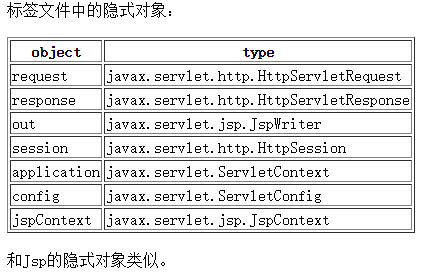定制JSP标签可以实现一些JSTL和EL没有提供的功能,基本步骤就是编写标签处理器然后注册标签。从JSP2.0以后,可以直接编写标签文件(.tag)来代替定制JSP标签。
相比定制JSP标签,标签文件无需编写Java代码,无需注册标签,只需要在tag文件中写代码逻辑即可。
一个简单的例子:
在WEB-INF下创建tags文件夹,然后在里面新建一个firstTag.tag文件:
1 | <%@tag import="java.util.Date"%> |
然后在firstTagTest.jsp页面中使用它:
1 | <%@ taglib prefix="mt" tagdir="/WEB-INF/tags"%> |
部署到Tomcat中,启动服务,访问该jsp,页面显示:

That’ all.
标签文件中的隐式对象:
| 对象 | 类型 |
| request | javax.servlet.http.HttpServletRequest |
| response | javax.servlet.http.HttpServletResponse |
| out | javax.servlet.jsp.JspWriter |
| session | javax.servlet.http.HttpSession |
| application | javax.servlet.ServletContext |
| config | javax.servlet.ServletConfig |
| jspContext | javax.servlet.jsp.JspContext |
和Jsp的隐式对象类似。
标签文件指令
tag指令
tag指令常用属性:
| 属性 | 描述 |
| display-name | 通过XML工具显示的简称,默认为标签名 |
| body-content | 标签主体内容的信息,可以为empty,tagdependent或scriptless(默认) |
| import | 导入Java类型 |
| pageEncoding | 指定编码 |
| isELIgnoreds | 是否使用EL表达式 |
include指令
该指令可以引入静态文件(HTML文件)或动态文件(另一个标签文件)。
如有静态HTML文件included.html:
1 | <table border=1> |
included.tag文件:
1 | <%@tag pageEncoding="utf-8" %> |
在include.tag标签中引用included.html和included.tag:
1 | <%@tag pageEncoding="utf-8"%> |
在jsp页面中测试:
1 | <%@taglib prefix="mt" tagdir="/WEB-INF/tags" %> |
启动访问,页面显示:

taglib指令
该指令的作用就是在一个标签文件中使用另外一个标签,如现有taglibDemo.tag:
1 | <%@ taglib prefix="mt" tagdir="/WEB-INF/tags" %> |
该标签调用了第一个例子中创建的firstTag标签。
attribute指令
该指令在标签中使用属性,attribute常用的属性有:
| 属性 | 描述 |
| name | 属性名 |
| required | 是否式必须的,默认为false |
| type | 类型,默认为String |
1 | <%@tag import="java.util.Date"%> |
jsp中测试:
1 | <%@ taglib prefix="mt" tagdir="/WEB-INF/tags" %> |
页面显示:

variable指令
用于定义标签文件的变量,常用的属性有:
| 属性 | 描述 |
| name-given | 变量名 |
| scope | 范围 |
| description | 描述 |
1 | <%@tag import="java.text.SimpleDateFormat"%> |
jsp页面引用:
1 | <%@ taglib prefix="tags" tagdir="/WEB-INF/tags" %> |
测试,页面显示:


